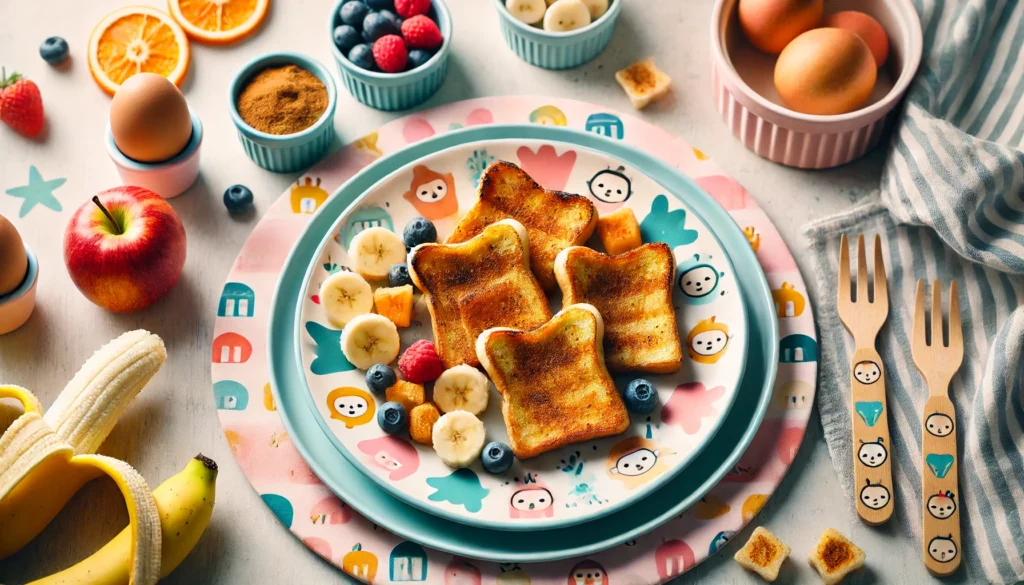
French toast is a versatile and nutritious meal that can easily be adapted for babies starting at 6 months, all the way through to preschoolers and beyond. It’s a great way to introduce eggs, bread, and flavors to your little one’s diet. Whether you’re looking for a French toast recipe with or without eggs, it can become a family favorite for breakfasts or even snack time.
Let’s dive into how you can serve French toast for babies with or without eggs at different stages of development, and how to make it a healthy, fun food for kids!
Choosing the Right Bread
The type of bread you use is crucial for making the perfect baby-led weaning (BLW) French toast for babies. Here are some factors to consider:
• Whole Grain or Multigrain Bread: For added fiber and nutrients, whole grain or multigrain bread is an excellent choice. It’s less processed, contains more fiber, and provides a slower release of energy.
• For babies and toddlers who are just getting used to solid foods, opt for a softer bread that’s easier to chew and swallow. Avoid bread with large seeds or a very tough crust as it could pose a choking hazard.
• Babies’ kidneys are still developing, so opt for bread with little to no added salt. Many store-bought loaves can be high in sodium, so check the labels or consider making your own bread at home.
Choosing the Right Egg
When preparing French toast with egg for your baby, selecting the right egg is essential for both safety and nutrition. Opt for fresh, organic, and pasteurized eggs.
• Organic or Free-Range Eggs: Eggs are an excellent source of protein, vitamin D, and other essential nutrients. If possible, opt for organic or free-range eggs as they tend to have higher levels of nutrients like omega-3 fatty acids.
• Egg Alternatives: For those avoiding eggs due to allergies or dietary preferences, you can use alternatives such as mashed bananas, chia seeds mixed with water, or applesauce.
French Toast Recipe with Egg
This classic French toast with egg recipe can be modified to suit babies as young as six months, making it both nutritious and flavorful.
Ingredients:
• 1 slice of whole grain or soft bread (crusts removed for younger babies)
• 1 organic egg
• ¼ cup of milk (cow’s milk, or a plant-based alternative for older kids) – You can use some milk for cooking, that’s totally ok!
• A pinch of cinnamon (optional)
• A few drops of vanilla extract (optional)
Instructions: How to Make French Toast with Egg
Follow these simple instructions to prepare a delicious French toast with egg for your baby. This quick and easy recipe ensures a nutritious meal that’s perfect for little ones.
1. In a shallow bowl, whisk together the egg, milk, cinnamon, and vanilla extract (if using).
2. Soak the bread in the mixture until it’s fully saturated, but not falling apart.
3. Heat a pan on medium-low heat and lightly grease it with a little butter or oil (use sparingly for babies).
4. Cook the bread until golden brown on each side, about 2–3 minutes per side.
5. Let the toast cool to a safe temperature, then cut it into strips or bite-sized pieces, depending on your child’s age.
French Toast Recipe without Egg
If your child has an egg allergy or you prefer an egg-free version, don’t worry! This alternative French toast without egg is just as delicious and nutritious.
Ingredients:
• 1 slice of whole grain or soft bread
• ¼ cup of plant-based milk (or regular milk)
• 1 tbsp of mashed banana or 1 tbsp chia seeds mixed with 3 tbsp water (egg substitute)
• A pinch of cinnamon
• A few drops of vanilla extract (optional)
Instructions: How to Make French Toast without Egg
Here’s how to make the perfect French toast without egg for your baby. Follow these step-by-step instructions to create a soft, flavorful dish that’s safe and nutritious.
1. In a shallow bowl, mix the milk, mashed banana (or chia mixture), cinnamon, and vanilla extract.
2. Soak the bread in the mixture until well coated.
3. Heat a pan on medium-low heat and add a little butter or oil.
4. Cook the bread until golden brown on both sides, 2–3 minutes per side.
5. Let cool and serve in the appropriate size for your child.
French Toast Size by Age
When serving French toast to babies or kids, it’s essential to adjust the size and shape based on their age and developmental stage to prevent choking and make self-feeding easier.
French Toast for 6 to 9 Months Babies:
• At this stage, babies are just starting out with finger foods, and long strips of soft French toast are ideal. Cut the toast into finger-sized pieces that are easy for them to grasp with their little hands. Removing the crusts can also make it easier for them to chew and swallow. It’s a great option for your baby’s first foods during baby-led weaning.
French Toast for 9 to 12 Months Babies:
• By now, babies are better at chewing, and you can offer smaller pieces—about bite-sized squares of French toast with or without eggs. You can leave the crust on if the bread is soft, but always supervise them while they eat to prevent choking.
French Toast for 12 to 24 Months Toddlers:
• Toddlers are typically more confident eaters and can handle larger pieces of food. You can cut the French toast into quarters or halves depending on your child’s chewing abilities. Serve with a variety of toppings like mashed fruits or yogurt to make it more exciting.
French Toast for 2 to 4 years Preschoolers:
• Preschoolers can manage full slices or halves of French toast. You can also offer fun shapes using cookie cutters to make breakfast time more engaging. Toppings like a small drizzle of honey (for kids over 1 year), nut butter, or fresh berries can make it more flavorful.
French Toast for 4 to 6 years Kids:
• By this age, kids can eat French toast with eggs or without eggs just like adults, with full slices and a variety of toppings. You can encourage them to dip their French toast in yogurt, applesauce, or a small amount of maple syrup for fun and to foster independence in eating.
Nutritional Benefits of French Toast for Babies
• Protein: Eggs (or their alternatives) provide essential protein needed for growth and development.
• Carbohydrates: Bread offers energy for your child to stay active and focused.
• Vitamins and Minerals: Depending on the ingredients, French toast can provide key vitamins like vitamin D, calcium (from milk), and fiber (from whole-grain bread).
• Healthy Fats: If you use butter or oil, these contribute to the healthy fats needed for brain development.
In conclusion, French toast for baby is a versatile, nutritious option that can be tailored to suit your child’s developmental stage and dietary needs. Whether you choose to make French toast with eggs or opt for an egg-free version, this recipe offers a fun and healthy way to introduce important nutrients like protein, fiber, and essential vitamins. By adjusting the texture and portion sizes, you can ensure that your baby or toddler enjoys this meal safely while developing good eating habits. It’s a simple, delicious dish that can easily become a family favorite for years to come!
Know your guide

Hello, amazing parents! I’m Riddhi Verma Ayyagari, a Stanford-certified Child Nutritionist and Baby-Led Weaning Expert. With years of experience and a proven approach, I’ve helped 8000+ of families navigate child nutrition, from starting solids to tackling picky eating.
Make mealtimes easier and more enjoyable with personalized 1:1 Sessions and my expert-led MasterClass. Start your journey to stress-free feeding today!
